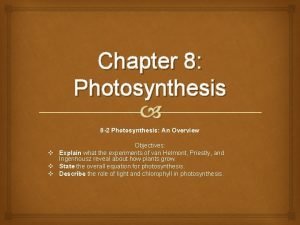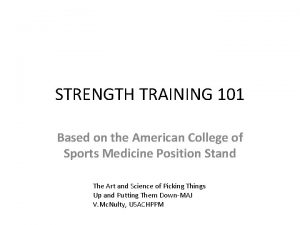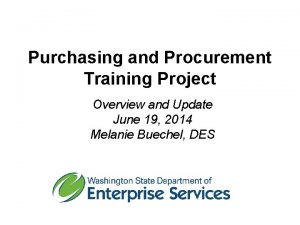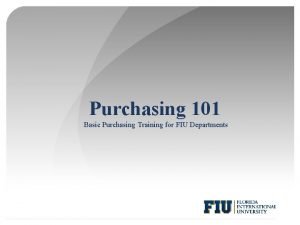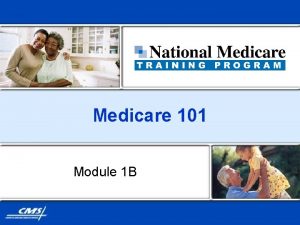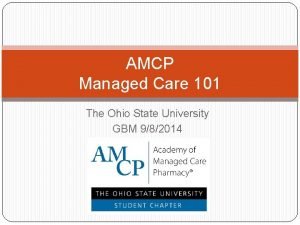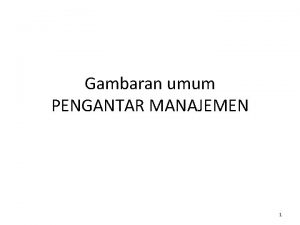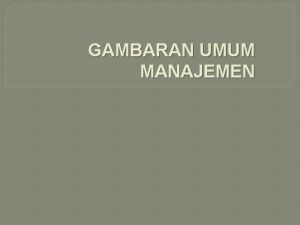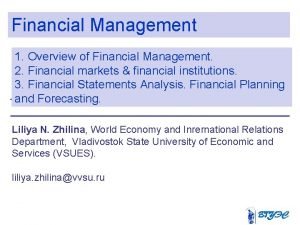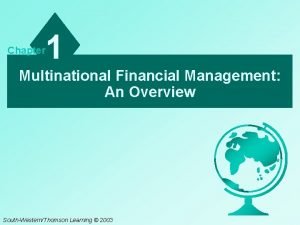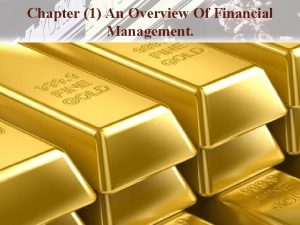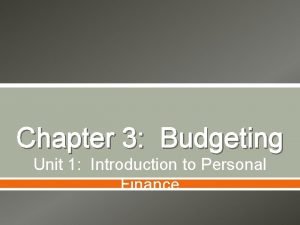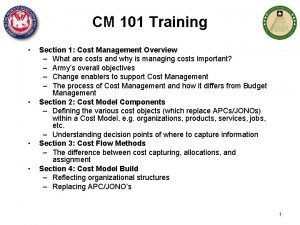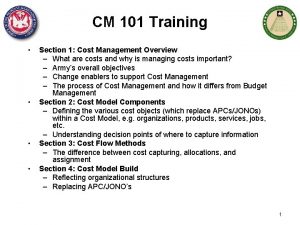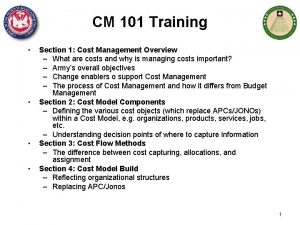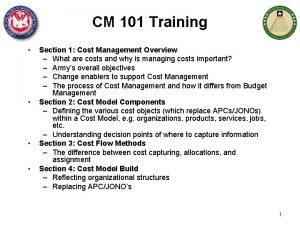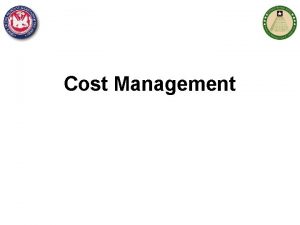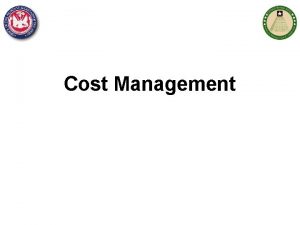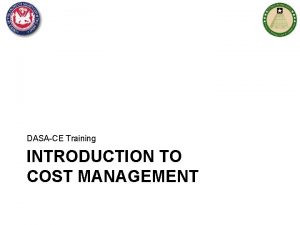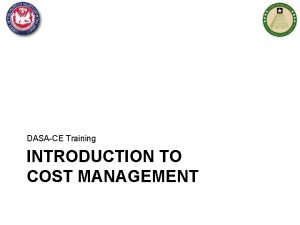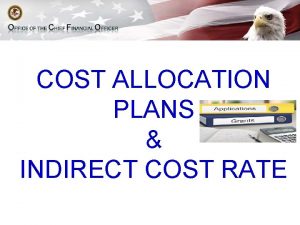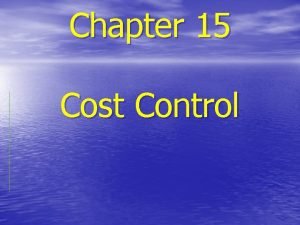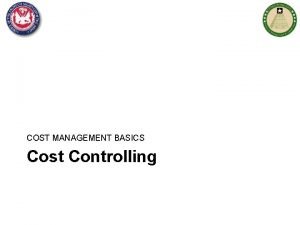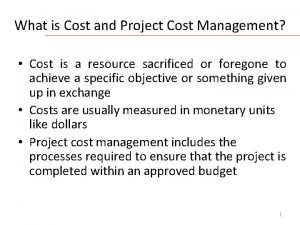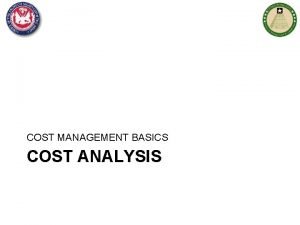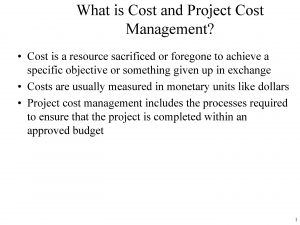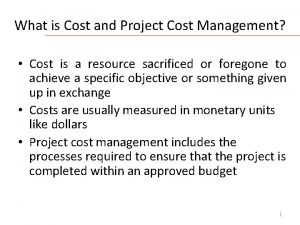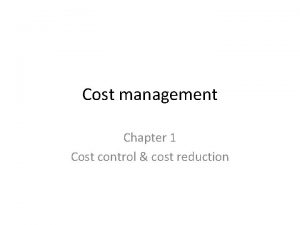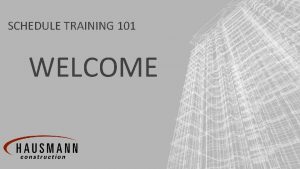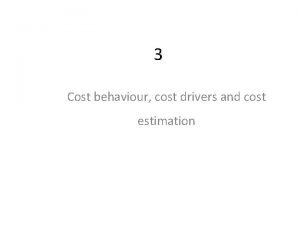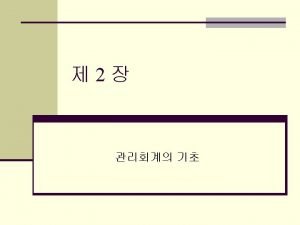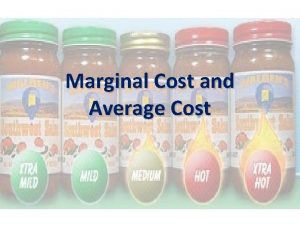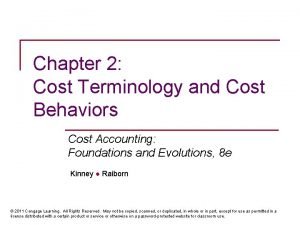CM 101 Training Section 1 Cost Management Overview































- Slides: 31

CM 101 Training • • Section 1: Cost Management Overview – What are costs and why is managing costs important? – Army’s overall objectives – Change enablers o support Cost Management – The process of Cost Management and how it differs from Budget Management Section 2: Cost Model Components – Defining the various cost objects (which replace APCs/JONOs) within a Cost Model, e. g. organizations, products, services, jobs, etc. – Understanding decision points of where to capture information Section 3: Cost Flow Methods – The difference between cost capturing, allocations, and assignment Section 4: Cost Model Build – Reflecting organizational structures – Replacing APC/Jonos 1

Lesson 1: Cost Assignments Overview Objective(s): Understand the different cost flow methods, the information needed, the Army objective of which method to use. S 3 L 1_p 2

Cost Flow Overview Capturing costs is utilized in order to reflect: • • • S 3 L 1_p 3 Budget Execution The full costs of organizations The full costs of products/services The full costs of customers How organizations can influence the costs by their behavior (output consumption)

Cost Flow Overview Full Cost Organizations IMCOM: Garrison TRADOC: Ranger School FORSCOM: 1 st Brigade Combat Team S 3 L 1_p Full Cost Product/Services: SSP 29 A, 31 B Full Cost Customers - Tenants Courses: Mission technique classes, combative training - Division / BCT - MOS - FMS - Ready Unit - Capability Mission Commander • Section 2 focused on the shapes depicted in the Cost Model • Section 3 focuses on the arrows in the Cost Model 4 4

Cost Flow Methods Full Cost Organizations IMCOM: Garrison TRADOC: Ranger School FORSCOM: 1 st Brigade Combat Team Full Cost Product/Services: SSP 29 A, 31 B Full Cost Customers - Tenants Courses: Mission technique classes, combative training - Division / BCT - MOS - FMS - Ready Unit - Capability Mission Commander There are three types of Cost Flows: • Direct Charge – the primary or initial posting • Assignments – secondary or follow-on movement based on quantity consumption (has Rate x Qty consumed) • Allocations – secondary or follow-on movements that are value based ($ or # converted to a % split) S 3 L 1_p 5 5

Assignment vs. Allocation: The establishment of relationship between a sending cost object and a receiving cost object based on a quantity (with a rate for valuation) being consumed by the receiver The establishment of a relationship between a sending cost object to one or more receiving cost object(s) based on % (even if a quantity is utilized to generate a %, e. g. # FTEs) Requires: • Activity Type or Business Process quantity as sender • A rate associated to valuate the quantity flow • Mechanism for capturing or imputing the sender quantity Requires: • Mechanism for capturing a quantitative or monetary value on the receiver(s) which is then utilized to determine the % split of the sender costs • Acceptance of batch processing $220 -$200 S 3 L 1_p 6 0@ Hr $ Order 1 8 EE’s 1 10 @ $10 CC 1 Order 2 50 CC 1 10 % Assignment: 50% Order 1 160 Hrs Order 2 160 Hrs

Assignment vs. Allocation Assignment: Allocation: Pros: • Direct relationship • Real-time information for analysis • Reduces systemic burden during period close • Dynamic (can change as the environment changes) • Capacity Mgmt (resource utilization) Pros: • Provides mechanism for cost association when tracking of quantity is not possible or cost prohibitive Cons: • Must have the ability to track quantity from send to receiver or impute Cons: • Full-absorption approach • Typically less accurate • High demand on system resources during period-end close • Static assumption set often infrequently updated S 3 L 1_p 7

Allocation to Assignment Maturation Process 100% Value-Based Quantity-Based 80% 60% 40% 20% 0% Year 1 Year 2 Year 3 Year 4 Year 5 Year N • As the Army’s Management Accounting framework matures over time, utilization between cost allocation versus assignment methods will shift. • Value-based: Cost allocations utilizing tracing factors that result in the allocation of dollars between cost objects, e. g. % split or quantitative information such as # FTEs. The result is the cost flow of dollars only. Supports current costing with limited management control and projection capabilities. S 3 L 1_p 8 • Quantity-based: Cost assignments utilizing the quantity of goods and services provided between cost objects, e. g. # Hrs, SQFT, CPUMINS, etc. The result is the flow of quantities between cost objects with a corresponding monetary valuation. Therefore both quantities and dollars flow. Supports current costing with management control and projection capabilities.

Capturing Costs Today: ü Not All Cost Allocated ü Focused on Direct Obligation by Appropriation ü Assigned / Mapped to High Level Programs (e. g. MDEP) ü Allocation Done Differently by Organization Tomorrow: ü Standardized Process ü Will Use Acceptable Cost Assignment/ Allocation Practices ü Will Provide Capability for Multiple Cost Assignments/Allocations ü Allocations Only where Direct Assignments not Used • Inconsistent Army Reporting • Not Full Cost • Financial Focus to Meet Budget Execution Reports • Not linked to Output • Required for Full Cost Accuracy • More Accurately Defines Overhead & Indirect Cost • Maintains Budget Execution Capability • Linked to Output S 3 L 1_p 9

Lesson 1: Wrap-Up • There are 3 forms of cost flows: direct charge, assignments, and allocations • The primary or initial posting is directly charged to the Cost Object • Further associations of the costs to consuming organizations, products/services, uses assignments/allocations • Assignments utilize a generic basis providing both a rate & quantity consumed (e. g. SQFT) • Allocating utilizes a value basis (either amount or value) to calculate a percentage split. S 3 L 1_p 10

Lesson 2 Capture Output Costs Objective(s): • To understand which outputs are captured, how the outputs are classified (quantitative or qualitative) and how these outputs are captured S 3 L 5_p 11

Capture Output Costs Overview • In addition to capturing cost, non-financial quantity information is necessary to support Cost Management • Non-financial quantity information can be: – Quantitative, e. g. # of helpdesk tickets, # students – Qualitative, e. g. average # days to close helpdesk ticket, % Completion Rate S 3 L 5_p 12

Capture Output Costs Decisions • Does the output quantity support the cost by BCT/ARFORGEN? HQ Need? or Field product/services? – (e. g. ammo used for training, # soldiers) • Is the output quantity currently used by scheduling/operational managers on a timely basis? • Can an output change the behavior of an organization/individual to be more efficient and effective (e. g. # cancelled course registrations in ATAARS) • Are output quantities used for justifications and/or requests for funding? • If it supports cost management – efficiently & effectively then considered S 3 L 5_p 13

Capturing Output Costs Posting Data • Output Costs are captured as SKF’s, Activity Types, or Business Processes SKF # ACT TYPE BPR • Entry Methods: – Interface: Direct communication from legacy system to ERP – Load Spreadsheets: Taking an output of an existing legacy system (command control), formatting appropriately, and processing in ERP – Direct Entry: Currently captures manually or taking a low volume output from existing system and posting an aggregate of the values in ERP S 3 L 5_p 14

Capturing Output Costs Analysis • Understanding the dollar amount of unit provided, based on number delivered Cost/Per • Understanding the relationship between Resource Capacity to Output generation (e. g. 3 Hrs: 1 Output) 100% 80% Capacity 60% 40% Actual Output 20% 0% Month 1 Month 2 S 3 L 5_p 15 Month 3 Month 4 Month 5 Month N

Capturing Output Costs Analysis • Visibility across the Army as to what tasks should costs Number of Tickets – Supports Comparative Analysis between sites, tasks, types of work, groups of resources to identify best practice vs. inefficiencies – Allows for realization of trade-offs between delivery and resource consumption Cost of Closing Tickets S 3 L 5_p 16

Capture Output Costs Analysis 2 ABM 0065: AMMO SUPPLY 2 ABM 0014: LEGAL (ILO) Name Cost Element Amount Quantity Name Cost Element Ammo Perm 9400. AMMO $5, 000 6100. 11 B 1 10 hrs EA 100 AMMO FIRED 10 rounds at $50 WARS Training Event (UIC) Name Cost Element Ammo 9400. AMMO Amount Quantity $500 10 EA Qty is valuated with rate AMOUNT AND QUANTITY ARE THE OUTPUTS OF THIS PROCESS S 3 L 5_p 17

Lesson 2 Wrap Up • Output measures can be used to justify resources, to capture total costs, to influence behavioral changes, to retain operation tasks completed daily. • The output measures facilitate both qualitative and quantitative measures. This can also be viewed as efficiency and effectiveness: – How efficiently are resources utilized (e. g. how much is expended to close a ticket in 4 hrs, 8, hrs, 2 days? ) – How effectively is the product/service provided to the customer? (e. g. how long does it take for me to close a ticket) S 3 L 5_p 18

Lesson 3: Summary/Key Take -Away’s Objective(s): • Highlight the most important concepts addressed throughout the training S 4 L 3_p 1

What is Cost? Resources Consumed “Cost is a monetary measure of the sacrifice associated with: • expending resource functionality to achieve a specific objective, or • utilizing resource output required to achieve a specific objective, or • the provision of resource functionality or resource output while not using it. * www. rcainstitute. com - RCA Taxonomy S 4 L 3_p 2

Need to Understand What the Resources Buy – The Army Product Ensure Strategic X Objectives are Effectively & Efficiently X X Effectively Resourced Produce Outputs Heavy Stryker on t. C ge ud /B m Services & Infrastructure ct u tr • Products/Services • Organizations (Cost Centers) • Resources (Labor, Equipment, Assets) s on og ra Readiness t. C Pr Synch Board en Capital Materiel • ARFORGEN m ge Human • CG • IMCOM a an ARFORGEN • CG • FORSCOM t. M • CG • AMC os S 4 L 3_p 3 • CG • TRADOC C str uc t Light

Army Cost Management Framework X X ARFORGEN Heavy • Research • Procure • Sustain • Distribute • Dispose Materiel Human Capital Services & Infrastructure ence g i l l e Int nd & rces a m • Com ating Fo t r il Eq • Ope M f o air / Rep t n i a ot M • Dep ance , n , T&E g n o • Ord & R&D i t ctin uisi • S&T ems Acq & Contra t • Sys ineering, ing Eng Train / n tio duca nel Svcs ing E v i • C rson n / Train e P v • Ci catio l Svcs u d uc. E • Mil ersonne ment Ed P • Mil Develop Svcs f. mily y & a • Pro F t & nity l Securi s u m a • Com ronment urce Svc i o • Env nal Res n t o i t Na mmo cs y Mg t o v i l C i S c a s lth • Hea llation / F to CE a E • Inst e to C u q i Un S 4 L 3_p 4 Note: Program / Budget and Cost Management constructs shown represent subset of overall framework Cost Management Construct Readiness Stryker Operation Planning & Control • Train Units • Operations & Activities Light Communications, Computing, & Info Systems Financial Management / Budget Program / Budget Construct Available / Deploy Train / Ready Reset • Acquire & Train • Manage (Pay) & Distribute • Develop & Educate • Force Development • Facility • Installation • Command Programs • Centrally Managed Programs X

Cost Management Focus COST MANAGEMENT FOCUS Inputs S 4 L 3_p 5 Resources: Labor Material Equipment Supplies Contracts Assets Conversion “Work” Work Performed by Organizations (Cost Centers) to Produce Products and Services for Customers Outputs Products Services: Courses Services Support Programs Tests Research Projects Training Events 23

Cost Management Managing Business Operations Efficiently & Effectively Through the Accurate Measurement & Thorough Understanding of the "Full Cost" of an Organization's Business Processes, Products & Services in Order to Provide the Best Value to Customers. Cost Accounting Cost Planning S 4 L 3_p 6 Cost Management Process Cost Controlling Cost Analysis

Army Cost Culture Change “Making a Square a Circle” “A Culture of Influence” “A Culture of Entitlement” • Budget-focused • Spend rate driven – inputs • Performance objective -99. 9% obligated • Free goods has infinite demands • Develop/Recruit Analysts • Enhance Training • Performance Focus (NSPS) Policy How To’s • Process Improvement (Lean 6 -Sigma) • Integrated Business Design • Results driven - output & outcome • Performance objective – resource consumption optimization (efficiency & effectiveness) • Use what is necessary to obtain the objective • ERP Applications e. g. (GFEBS, LMP, GCSS) • Business Warehouses • Executive Scorecards S 4 L 3_p 7 • Cost and performance focused Enablers of Change

Enhanced Ability to Capture Cost Objects Organizational Entities ERP (SAP) Cost Centers Cost Collectors Army Examples • Installation • Brigade • School • Directorate • Lab Real Property / Equipment Program / Project Task / Activity Special Event or Initiative Assets / Real Estate Objects Project / WBS Business Process Internal Order • Acquisition • Building • Training Range • RDTE Project • Weapon System • MILCON Project • System Test • BRAC • Services • Instructional Course • Training Event • Mandatory • Repair Process Training • Test Run • Support to Olympics Cost assigned Directly or Indirectly Customer / Product S 4 L 3_p 8 • Weapon System • Brigade • PEO / PM • Tenant • Command • Course

Army Cost Design Full Cost Organizations IMCOM: Garrison TRADOC: Ranger School FORSCOM: 1 st Brigade Combat Team Full Cost Product/Services: SSP 29 A, 31 B Courses: Mission technique classes, combative training - Ready Unit - Capability Full Cost Customers - Tenants A monetary valuation of the economic goods and - Division / BCT services of - MOS - FMS the organization – full burden cost flows Mission Commander maturation over years S 4 L 3_p 9 27

Costing Conceptual Design What/Why information is entered, stored, used, and presented Cost Accounting Cost Planning Cost Management Process Cost Analysis How the information is entered, stored, used, and presented Cost Controlling End User Presentation Layer S 4 L 3_p 10 Publi c Secto r Budget Accounting Where the information is entered, stored, used, and presented

Many Types Costs • Direct costs— A cost such as labor, materials/supplies that can be directly traced to producing a specific output of an organization, product/service. • Indirect costs – A cost that cannot be directly traced to a specific organization, product/service output. • Funded Costs -- The value of goods or services received because of an obligation of funds (obligation authority), by the organization performing the work. • Unfunded costs -- A cost that are financed by another organization's or activity's appropriations. • Variable Costs -- A cost that changes with change in output. • Fixed Cost -- A cost that remains the same regardless of the change in output. • Recurring Cost -- A cost that is incur repeatedly for each organization and/or product/service produced. • Non-Recurring Cost -- A cost that is unusual and unlikely to occur again. • Avoidable Costs -- A cost incurred on an object that will no longer be incurred due to a decision to change the output. • Unavoidable Cost -- A cost incurred on an object that will be incurred regardless of the decision to change. S 4 L 3_p 11 • Common Understanding of Types of Cost is Necessary for Informed Decision Making • Each Decision Should be Focused on Only Relevant Cost that Impact the Decision

Cost Objects • Cost Center - A cost center is a responsibility center that incurs costs and has a manager who is accountable for those costs. • Activity Type - An Activity Type is a cost object that represents a group of resources within a Cost Center. These resource groups have capacity and a unit of measure such as: labor hours, machine hours, square footage, etc. Activity Types are consumed and utilized to the produce the products and services of the organization. • Cost Element - A Cost Element is the lowest level component for classifying costs and revenues (as negative costs) of a resource and indicates the category/type associated with a posting (e. g. allocation type, revenue, expense) • WBS Element - WBS elements are activities in the Project used for planning and updating cost data. Some examples of WBS Elements are: Tasks, Partial tasks that are further subdivided, and work packages. • Order - Orders are cost objects used to plan, collect, monitor, and settle the costs of specific jobs and tasks. Orders are used to monitor the costs of short term projects and event/job costing. • Business Process - A business process is a cost object used to capture costs of cross-functional (cost center) activities. Other: • Statistical Key Figure - A Statistical Key Figure is a piece of information about the cost object it is assigned to, e. g. # FTE for a cost center, # telephones, etc. S 4 L 3_p 13

Cost Management Enables Optimization Outputs/Consumers Providers/Inputs relating Cost of Brigade Weapon Sys $ (VAMOSC) $ $ $ Direct $ $ assign $ $ HQDA Direct Military Pay Contracts (CLS) assign Army Service Component Commands Direct Reporting Unit Army Commands Unit Training • Ground OPTEMPO Installation • SSP 1 (Labor Tracking) School Training • Initial Entry Equip the Force • Acquisition S 4 L 3_p 14 Direct GFEBS enables Army to “slice and dice” data for decision-making $
 Chapter 8 section 2 photosynthesis answer key
Chapter 8 section 2 photosynthesis answer key Basic principles of cost management in project management
Basic principles of cost management in project management Weight training 101
Weight training 101 Procurement 101 training
Procurement 101 training Fiu procurement
Fiu procurement Payments 101 training
Payments 101 training Freenpeople
Freenpeople Amcp osu
Amcp osu Content database software
Content database software Intro to hrm
Intro to hrm Management topics for project
Management topics for project Gym management system comparison
Gym management system comparison The forrester wavetm real-time interaction management
The forrester wavetm real-time interaction management Management overview
Management overview 4 prinsip taylor dalam tahapan
4 prinsip taylor dalam tahapan Overview of financial management
Overview of financial management Multinational financial management meaning
Multinational financial management meaning Chapter 1 an overview of financial management
Chapter 1 an overview of financial management An overview of financial management
An overview of financial management Unit 1 chapter 3 budgeting answers
Unit 1 chapter 3 budgeting answers Cost accumulation and cost assignment
Cost accumulation and cost assignment Cost accumulation and cost assignment
Cost accumulation and cost assignment Manufacturing cost vs non manufacturing cost
Manufacturing cost vs non manufacturing cost Job costing and process costing
Job costing and process costing Wacc example
Wacc example Commited cost
Commited cost Cost accumulation and cost assignment
Cost accumulation and cost assignment Manufacturing cost vs non manufacturing cost
Manufacturing cost vs non manufacturing cost What is standard costing and variance analysis
What is standard costing and variance analysis Cost of equity
Cost of equity Cost accumulation and cost assignment
Cost accumulation and cost assignment Dennis geyer
Dennis geyer
